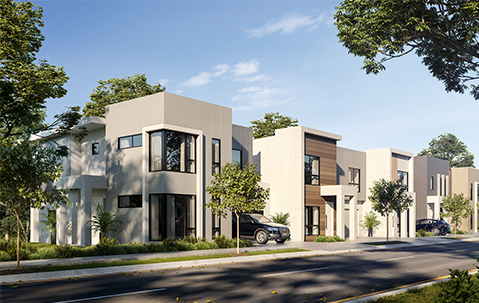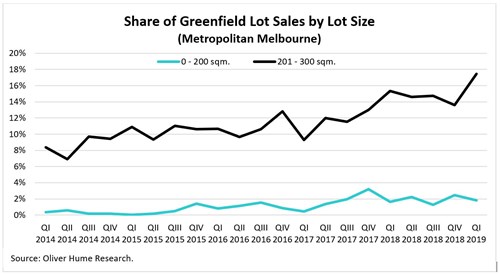News & Tips

The rise of the townhouse – a new era for Melbourne housing
May 27, 2019
George Bougias
National Head of Research, Oliver Hume
Continued growth in house prices, especially in inner and middle Melbourne, combined with changing lifestyle expectations and demographics is leading to significant growth in demand for various medium density dwelling types including townhouses.
While Australians, and particularly Victorians, continue to build some of the biggest homes in the world, a report released by CommSec (using commissioned data from the Australian Bureau of Statistics (ABS)) showed that the average floor size of Australian homes (houses and apartments) fell to a 22-year low of around 186 square metres, the smallest since 1996.
Smaller dwelling sizes reflect a range of factors including an increased number of apartments and townhouses. The report concluded, quite simply, that demographic change will continue to underpin structural changes in the housing market. As the average number of people in homes declines and the total population increases, there will be a need for an increasing number of smaller homes to be constructed. This requirement will present both opportunities and challenges for the property and finance industries and for owner-occupiers and investors alike.
Traditional houses on a sizable block of land, including a backyard and front garden, have been the typical housing product (especially in greenfield markets) as well as being the aspiration of many who seek the great Australian dream. The increased prevalence of apartments saw this dwelling mix change over the last two decades with the aspirations of some market segments also changing.
More recently the increased release frequency of townhouses has been part of the next wave reshaping the housing market, this is leading to both a supply response (as developers endeavour to respond to changing market conditions) and a demand response (as an increasing share of buyers opt for this type of dwelling product).
There are several factors and trends driving townhouse demand all of which are expected to continue indefinitely into the future.
The first is demographics. Australia’s population is growing rapidly and ageing and family and household sizes are getting smaller. Going forward, the expectation is that there will be sustained growth in one and two person households. The ABS projects that between 3.0 and 3.5 million people could be living alone in 2041. This is up from 2.3 million in 2016, representing an increase of 32% and 53% respectively.
The second and related factor is lifestyle. The owners and renters of inner and middle suburban dwellings are increasingly market segments that place a major value on retail, entertainment, social and other amenities. In many cases, the demanding occupations and lifestyle preferences of these residents leave little time for home maintenance and gardening. Mowing the lawn, once a regular tradition in suburban Melbourne, has been replaced by a coffee at the local café.
The third factor is design. Form and function harmoniously combined - creative, efficient and smart architecture both inside and out can provide townhouses with an attractive and modern appearance while also maximising available space.
The fourth and fifth (related) factors are policy and pricing respectively. With an urban growth boundary that limits the physical expansion of urban development it is a given that land prices will continue to rise especially where population growth has been robust (as it has been in Melbourne).
While apartments have increased the efficiency of urban land use, townhouses have also proven to be an important product option in the new dwelling mix especially in markets where traditional houses were once the only option for buyers (such as in outer suburban areas and greenfield markets). Indeed, an increasing number of townhouses and smaller lot products in the greenfield has been one of the reasons that median lot sizes have declined and the share of smaller lots have increased.

In many cases new townhouses are priced below that of new houses. This is because although a townhouse might have the same built area as a house (but distributed across multiple levels) the smaller average lot sizes in the case of townhouses can significantly reduce the overall price of the lot price.
This is increasingly important in outer suburban areas and greenfield markets where a lower absolute price is important for various market segments especially first home buyers and those looking to enter the market for the first time.
And despite rising building costs, recent data from the ABS suggests that, commensurate with the smaller built size, townhouse construction costs remain much lower than that of a typical new house.
For example, ABS estimates suggest that the average cost of building a house in Australia increased by nearly 75%, increasing from around $179,500 in 2003-04 to around $313,800 in 2017-18. Over the same time the average cost of building a new townhouse in Australia increased by less than 70%, increasing from around $147,300 in 2003-04 to around $250,200 in 2017-18.
This makes the average built cost of a new townhouse around a fifth lower than that of a new house on build cost alone. Factor in the need for much smaller land sizes and the absolute price for a townhouse becomes even more affordable.

With the surge in Melbourne’s house prices over the recent cycle, the pivot to townhouses from first home buyers, investors and other buyers in recent years is not surprising as townhouses have continued to provide a lower absolute entry price to established housing.
Access to finance has also played a key role. A few years ago, buyers with a $100,000 deposit were able to have their pick of homes as lenders competed heavily to grow their loan books. Now, tighter lending conditions, higher serviceability requirements and a Royal Commission means the same $100,000 deposit doesn’t create the same borrowing power. With less borrowing available, buyers have had to settle for properties with lower prices. Moreover, with less land required coupled with lower build costs, townhouses are now often the preferred option for buyers less interested in apartments or houses but with around $500,000 to $800,000 to spend.
From affordability to smart designs and buyers’ lifestyles, it is little wonder that demand is growing rapidly for townhouses. Although traditional houses and apartments will remain important townhouses will increasingly be the preferred option for a growing pool of buyers.

